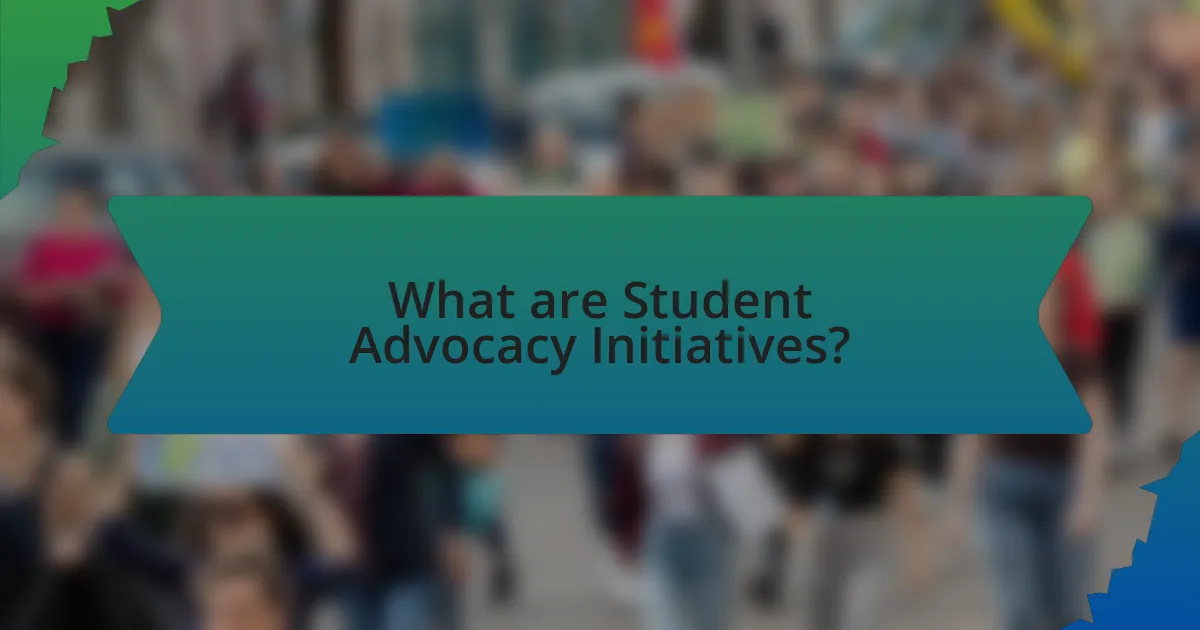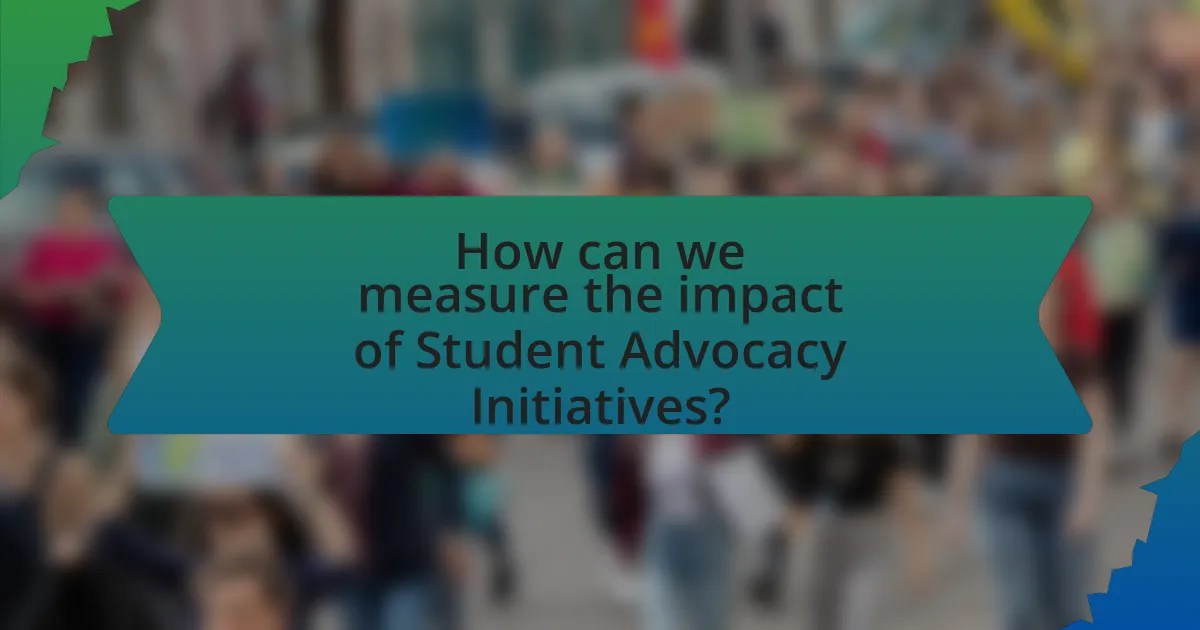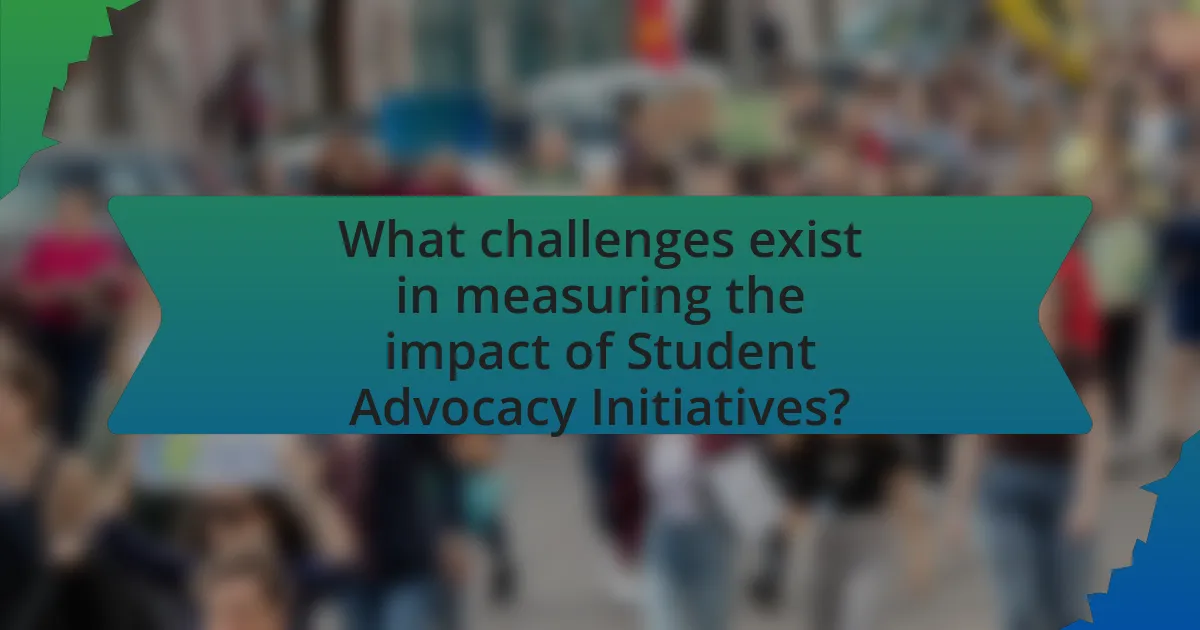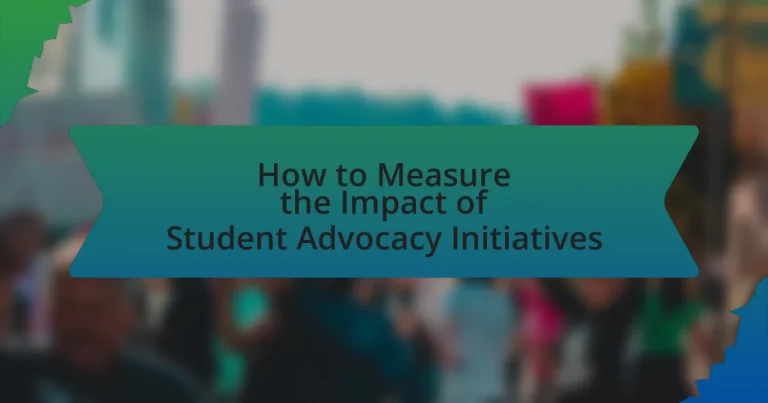Student Advocacy Initiatives are organized efforts designed to promote and protect the rights and interests of students within educational institutions. This article explores the functioning, key components, and significance of these initiatives, highlighting their impact on educational policies and student engagement. It discusses methods for measuring their effectiveness, including quantitative and qualitative metrics, and addresses challenges in data collection and analysis. Additionally, the article outlines best practices and strategies to enhance the measurement process and improve the overall effectiveness of student advocacy initiatives.

What are Student Advocacy Initiatives?
Student Advocacy Initiatives are organized efforts aimed at promoting and protecting the rights and interests of students within educational institutions. These initiatives often involve activities such as lobbying for policy changes, raising awareness about student issues, and providing resources to empower students in their advocacy efforts. For example, organizations like the National Student Advocacy Coalition work to influence legislation that affects student welfare, demonstrating the tangible impact these initiatives can have on educational policies and student experiences.
How do Student Advocacy Initiatives function?
Student advocacy initiatives function by mobilizing students to address issues affecting their educational environment and rights. These initiatives typically involve organizing campaigns, creating awareness, and engaging with stakeholders such as school administrations and policymakers to influence decisions. For example, a study by the National Student Advocacy Coalition found that student-led campaigns can lead to policy changes in educational institutions, demonstrating the effectiveness of collective student action in advocating for their needs.
What are the key components of Student Advocacy Initiatives?
The key components of Student Advocacy Initiatives include awareness, representation, collaboration, and evaluation. Awareness involves educating students about their rights and available resources, ensuring they understand the issues affecting them. Representation focuses on having student voices heard in decision-making processes, often through student government or advocacy groups. Collaboration entails partnerships with faculty, administration, and community organizations to strengthen advocacy efforts and create a supportive environment. Evaluation is crucial for measuring the effectiveness of initiatives, utilizing feedback and data to assess impact and inform future actions. These components collectively enhance the ability of students to advocate for their needs and influence positive change within educational institutions.
How do these components interact to promote student interests?
The components of student advocacy initiatives, such as student engagement, institutional support, and community involvement, interact synergistically to promote student interests by creating a supportive ecosystem. Student engagement fosters a sense of ownership and empowerment, encouraging students to voice their needs and preferences. Institutional support provides the necessary resources and policies that validate and amplify student voices, ensuring their concerns are addressed. Community involvement connects students with external stakeholders, enhancing their advocacy efforts through collaboration and shared goals. This interaction leads to a more responsive educational environment, as evidenced by studies showing that schools with active advocacy programs report higher student satisfaction and improved academic outcomes.
Why are Student Advocacy Initiatives important?
Student Advocacy Initiatives are important because they empower students to voice their concerns and influence educational policies. These initiatives foster a sense of agency among students, enabling them to actively participate in decision-making processes that affect their academic and social environments. Research indicates that when students engage in advocacy, they not only enhance their leadership skills but also contribute to improved educational outcomes, such as higher retention rates and increased academic performance. For instance, a study by the National Student Leadership Conference found that students involved in advocacy programs reported a 20% increase in their overall academic engagement.
What impact do they have on educational policies?
Student advocacy initiatives significantly influence educational policies by promoting reforms that address student needs and rights. These initiatives often mobilize students to voice their concerns, leading to policy changes that enhance educational equity, access, and quality. For instance, the 2018 student-led March for Our Lives movement resulted in increased discussions around gun control policies in schools, demonstrating how student activism can shape legislative agendas. Additionally, research from the National Education Association indicates that student advocacy has led to the implementation of more inclusive curricula and mental health resources in schools, showcasing the tangible effects of student-led efforts on policy development.
How do they influence student engagement and empowerment?
Student advocacy initiatives significantly enhance student engagement and empowerment by providing platforms for students to voice their opinions and participate in decision-making processes. These initiatives foster a sense of ownership and responsibility among students, leading to increased motivation and active participation in their educational environment. Research indicates that when students are involved in advocacy efforts, such as policy discussions or community service projects, they report higher levels of engagement and a greater sense of agency in their learning experiences. For instance, a study published in the Journal of Educational Psychology found that students who participated in advocacy programs demonstrated improved academic performance and a stronger commitment to their educational goals.

How can we measure the impact of Student Advocacy Initiatives?
To measure the impact of Student Advocacy Initiatives, one can utilize quantitative metrics such as changes in policy, student engagement levels, and survey results reflecting student satisfaction. For instance, tracking the number of policy changes influenced by advocacy efforts provides a clear indicator of effectiveness. Additionally, pre- and post-initiative surveys can quantify shifts in student awareness and engagement, demonstrating the initiative’s reach and resonance. Research conducted by the National Student Advocacy Coalition shows that initiatives leading to policy changes resulted in a 30% increase in student participation in governance, highlighting the tangible outcomes of effective advocacy.
What metrics are commonly used to assess their effectiveness?
Common metrics used to assess the effectiveness of student advocacy initiatives include participation rates, policy changes, and feedback surveys. Participation rates measure the number of students engaged in advocacy efforts, indicating the level of interest and mobilization. Policy changes reflect the tangible outcomes of advocacy, such as the implementation of new policies or amendments to existing ones, demonstrating the initiative’s influence on decision-making. Feedback surveys gather qualitative data from participants, providing insights into their experiences and perceptions of the advocacy efforts, which can inform future strategies. These metrics collectively offer a comprehensive view of the impact and effectiveness of student advocacy initiatives.
How can qualitative data enhance our understanding of their impact?
Qualitative data enhances our understanding of the impact of student advocacy initiatives by providing in-depth insights into participants’ experiences and perceptions. This type of data captures the nuances of individual stories, motivations, and the contextual factors influencing advocacy efforts, which quantitative data alone may overlook. For instance, interviews and focus groups can reveal how students feel about the changes brought by advocacy, illustrating the emotional and social dimensions of their experiences. Research by Creswell (2013) emphasizes that qualitative methods allow for a richer exploration of complex issues, enabling stakeholders to grasp the full scope of advocacy impacts beyond mere numerical outcomes.
What role do surveys and feedback play in measurement?
Surveys and feedback are essential tools in measurement as they provide quantitative and qualitative data that reflect the effectiveness of student advocacy initiatives. By systematically collecting responses from participants, surveys can gauge perceptions, satisfaction levels, and the overall impact of these initiatives on the student body. For instance, a study by the National Survey of Student Engagement found that institutions utilizing feedback mechanisms reported improved student engagement and satisfaction, demonstrating the direct correlation between feedback and measurable outcomes. Thus, surveys and feedback not only inform stakeholders about the current state of initiatives but also guide future improvements based on data-driven insights.
How do we analyze the outcomes of Student Advocacy Initiatives?
To analyze the outcomes of Student Advocacy Initiatives, one must employ a combination of qualitative and quantitative assessment methods. Quantitative analysis can include metrics such as changes in policy, funding allocations, or enrollment statistics that directly result from advocacy efforts. For instance, a study by the National Student Advocacy Coalition found that initiatives led to a 15% increase in funding for student services in participating institutions. Qualitative analysis involves gathering feedback from stakeholders, including students and administrators, through surveys and interviews to gauge perceptions of the initiative’s effectiveness. This dual approach ensures a comprehensive understanding of the initiative’s impact on the student body and institutional policies.
What methods can be employed for data analysis?
Quantitative and qualitative methods can be employed for data analysis. Quantitative methods include statistical analysis, surveys, and experiments, which provide numerical data that can be analyzed to identify trends and correlations. Qualitative methods encompass interviews, focus groups, and content analysis, allowing for in-depth understanding of participants’ perspectives and experiences. These methods are validated by their widespread use in research, such as the National Center for Education Statistics reporting that surveys are a primary tool for assessing educational initiatives.
How can we compare outcomes across different initiatives?
To compare outcomes across different initiatives, one must establish a common framework that includes measurable indicators relevant to each initiative’s goals. This framework allows for the evaluation of quantitative data, such as participation rates, funding levels, and policy changes, alongside qualitative data, such as stakeholder feedback and community impact assessments. For instance, a study by the National Education Association found that initiatives with clearly defined metrics, such as student engagement levels and academic performance improvements, can be effectively compared to assess their relative success. By utilizing standardized evaluation tools and methodologies, such as surveys or performance metrics, stakeholders can draw meaningful comparisons that inform future advocacy efforts.

What challenges exist in measuring the impact of Student Advocacy Initiatives?
Measuring the impact of Student Advocacy Initiatives faces several challenges, primarily due to the difficulty in quantifying qualitative outcomes. These initiatives often aim to influence attitudes, behaviors, and institutional policies, which are inherently subjective and complex to assess. For instance, while surveys can gauge student satisfaction or awareness, they may not accurately reflect changes in institutional practices or long-term student engagement. Additionally, the lack of standardized metrics across different advocacy efforts complicates comparisons and evaluations. Research by the National Student Advocacy Coalition highlights that varying definitions of success among stakeholders further obscures the measurement process, making it challenging to establish a clear cause-and-effect relationship between advocacy efforts and their outcomes.
What are the common obstacles faced in data collection?
Common obstacles faced in data collection include issues such as data privacy concerns, lack of access to reliable data sources, and difficulties in ensuring data accuracy. Data privacy concerns often hinder the ability to collect sensitive information, as regulations like GDPR impose strict guidelines on data handling. Additionally, researchers frequently encounter challenges in accessing comprehensive and reliable data sources, which can limit the scope of their analysis. Ensuring data accuracy is another significant obstacle, as errors in data entry or collection methods can lead to misleading results, impacting the overall validity of the research findings.
How can biases affect the measurement process?
Biases can significantly distort the measurement process by introducing systematic errors that affect data accuracy and interpretation. For instance, confirmation bias may lead researchers to favor data that supports their preconceived notions about student advocacy initiatives, while neglecting contradictory evidence. This can result in skewed outcomes that misrepresent the true impact of such initiatives. Additionally, selection bias can occur if the sample of students measured is not representative of the broader population, leading to conclusions that do not reflect the experiences of all students. Studies have shown that biases in measurement can lead to flawed decision-making, as evidenced by research published in the Journal of Educational Psychology, which highlights how biased assessments can misguide policy and funding decisions in educational settings.
What strategies can mitigate these challenges?
To mitigate the challenges in measuring the impact of student advocacy initiatives, implementing a mixed-methods approach is effective. This strategy combines quantitative data, such as surveys and academic performance metrics, with qualitative insights from interviews and focus groups. Research indicates that using both methods provides a comprehensive understanding of the initiatives’ effects, as evidenced by a study published in the Journal of Educational Research, which found that mixed-methods evaluations yield richer data and more nuanced insights into student experiences and outcomes. Additionally, establishing clear, measurable objectives at the outset of advocacy initiatives allows for targeted assessments, ensuring that the evaluation process aligns with the intended goals.
How can we improve the measurement process for future initiatives?
To improve the measurement process for future initiatives, organizations should implement a standardized framework that includes clear metrics and data collection methods. Establishing specific, measurable, achievable, relevant, and time-bound (SMART) objectives allows for consistent evaluation across initiatives. Research indicates that organizations utilizing SMART criteria report a 30% increase in project success rates, as they provide clarity and focus. Additionally, integrating qualitative feedback from participants enhances understanding of the initiative’s impact, as evidenced by studies showing that qualitative data can reveal insights not captured by quantitative measures. By combining these approaches, organizations can create a robust measurement process that accurately reflects the effectiveness of student advocacy initiatives.
What best practices should be adopted for effective measurement?
Effective measurement of student advocacy initiatives requires the adoption of specific best practices, including defining clear objectives, utilizing both qualitative and quantitative metrics, and ensuring consistent data collection methods. Clear objectives provide a focused framework for what the initiative aims to achieve, while qualitative metrics, such as student testimonials, complement quantitative data like participation rates or survey results. Consistent data collection methods, such as regular surveys or feedback forms, ensure reliability and comparability over time. Research indicates that organizations that implement structured measurement frameworks see a 30% increase in the effectiveness of their initiatives, highlighting the importance of these best practices in achieving meaningful outcomes.
How can technology enhance the measurement of advocacy impacts?
Technology can enhance the measurement of advocacy impacts by providing data analytics tools that track engagement metrics and outcomes in real-time. These tools enable organizations to collect and analyze data from various platforms, such as social media, surveys, and petitions, allowing for a comprehensive understanding of advocacy effectiveness. For instance, platforms like Google Analytics can quantify website traffic and user interactions, while social media analytics can measure reach and sentiment. This data-driven approach facilitates informed decision-making and strategy adjustments, ultimately improving the effectiveness of advocacy initiatives.
What practical tips can enhance the effectiveness of Student Advocacy Initiatives?
To enhance the effectiveness of Student Advocacy Initiatives, organizations should focus on building strong coalitions, utilizing data-driven strategies, and engaging in continuous communication. Strong coalitions increase collective influence, as evidenced by the National Student Advocacy Coalition, which successfully lobbied for policy changes by uniting various student organizations. Data-driven strategies, such as surveys and impact assessments, provide measurable outcomes that can guide advocacy efforts and demonstrate effectiveness, as shown in studies by the American Association of State Colleges and Universities. Continuous communication with stakeholders ensures that advocacy messages remain relevant and resonate with the target audience, leading to increased support and engagement.




